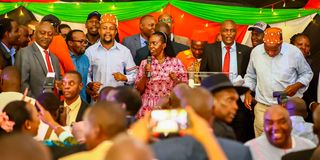Makau Mutua: Limuru III was a betrayal of Kenya

NARC Kenya leader Martha Karua (centre) leads a Kikuyu dance with other Mt. Kenya leaders during the Limuru 3 meeting at the Jumuia Conference Centre in Kiambu on May 17, 2024.
What you need to know:
- Has Ms Karua changed? I believe in redemption. That’s why I worked like hell to bring Ms Karua to Azimio in the 2022 elections.
- I vigorously rooted for her be Mr Odinga’s running mate, convinced she would have been a reformist powerhouse in an Azimio government.
There has been a loud conversation about whether the three major Mount Kenya sub-nations – Kikuyu, Meru, and Embu – should have convened in a political shindig they dubbed Limuru III. This isn’t an idle disagreement. GEMA blazed the trail during Mzee Jomo Kenyatta’s reign to the great detriment of Kenya as an idea.
Where Mwalimu Julius Nyerere, Tanzania’s founding leader and philosopher king, forged a nation out of disparate ethnicities, Mzee Kenyatta deliberately retarded – and actively thwarted – the construction of one nation called Kenya.
The man from Gatundu believed Kenya was the plaything of the Agikuyu. That’s why the revival of tribal jingoism in the name of a mongrel Limuru III must be rejected completely in toto as an anti-Kenya project. The saddest part for me is that the brainchild of Limuru III was Martha Karua, the one-time decorated progressive leader.
But perhaps we failed to understand Ms Karua.
Her most ignominious moment of infamy came after the stolen 2007 elections. In the aftermath, as Kenya devolved into political violence, Ms Karua was among those who unapologetically rejected calls for reviewing the election results which ODM’s Raila Odinga was believed to have won handily against PNU’s President Mwai Kibaki, the incumbent. The strife took ethnic overtones pitting the Kikuyu against the Luo.
In that moment, prominent players on the Kibaki side chose not the side of reason and the rule of law but ethnic intransigence. Has Ms Karua changed? I believe in redemption. That’s why I worked like hell to bring Ms Karua to Azimio in the 2022 elections.
I vigorously rooted for her be Mr Odinga’s running mate, convinced she would have been a reformist powerhouse in an Azimio government. Her election as Deputy President would have been historic and put her in a strong position to become the first female President of the Republic of Kenya. I had very high hopes for her.
Perhaps I should have heeded the metaphor about leopards and spots.
I don’t know how our running mate devolved into a caricature of a Mt Kenya kingpin, or “queenpin.” And not even a true ethnic kingpinship because Limuru III was a reject, a sad rump of GEMA. In the run-up to Limuru III, M. Karua and Jubilee’s Jeremiah Kioni had concocted another GEMA-like phantom which they called Kamwene.
That word means the same thing in Gikuyu and Kikamba: “mine only, for me, ours, or mine alone”. I was stunned. I made no bones about my disdain for the grouping and lit them up on my social media platforms and columns. Any leader worth their salt in Africa cannot be a naked advocate for tribal political cocoons.
That’s been the bane of the African state. When pressed, Ms Karua usually resorted to the intellectually lazy and disingenuous claptrap about how there was nothing wrong for “Mt Kenya people” to talk about “their issues” in their own group. There’s no doubt leaders in the Mt Kenya region are fighting each other for power. They have a huge share in the Kenya Kwanza government, to quote Deputy President Rigathi Gachagua.
That hasn’t put them at ease.
Those who were in Azimio have buyer’s remorse. They are adrift and out of power. That’s why Ms Karua and her ilk have retreated under the tribe’s skirt to fight for political relevance in the region. They have effectively left Azimio, which is a national project, to fight for leadership of the Agikuyu Nation. That’s what Limuru III was about.
The Meru and the Embu, as has historically happened, were included in the Agikuyu project to augment the “regional” appearance of the event. The history and the challenges of nationhood for the African post-colonial state demonstrate that tribalism is perhaps its biggest cancer.
African pre-colonial nations form the basis of the post-colonial states. To forge a united nation, no African state can afford to organise its politics around ethnicity.
None.
That’s the road to damnation. Nor can any responsible leader or progressive defend tribal political groups like GEMA.
I agree there could be some exceptions, especially where a group is manifestly marginalised and denied the basic rights of humanity and nationhood. In this category, I would put the Ogiek, the Maa, and other dispossessed groups that live on the margins of Kenya. None of the large groups such as the Kikuyu, Luo, Kalenjin, Luhya, and Kamba suffer such privation.
Let me state this without equivocation: No African state can prosper until it becomes an idea as a nation. That’s to say we don’t have to reject or deny our cultures or ethnic attributes, but it is to unapologetically understand ourselves as Kenyans first, and whatever else second. We must subordinate the tribe to the nation. This is especially true of the large dominant ethnic groups. They must never politically organise themselves in exclusive cocoons as happened in Limuru III.
Let’s be united politically by our ideas and ideology, not by the call of the blood, of the tribe.
Makau Mutua





